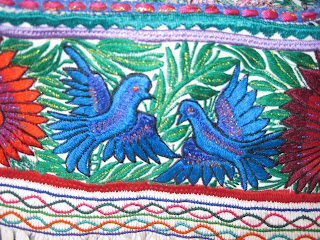Each Mayan village has its own distinctive dress. On our first day we traveled with Alex to the village of Tenejapa which was celebrating its annual feast of their patron, San Idelfonso. Men of political and religious status wore ribboned hats and black dresses woven from sheep hair along with various embellishments and accessories that identified their role. We were surprised to find out this dress was their daily attire, not just to be worn on this day of celebration. (These idigenous people do not like their photo taken as they believe it robs their soul so we had to be careful to only capture their dress from the rear.) The women had beautiful ribbons in their hair and wore village blouses and skirts, along with a wide, stiffly woven belt to help give them support in their daily activities of carrying heavy loads of wood, corn, and other items, not to mention children.
While in Tenejapa, we were allowed into their church while they prepared for their procession throughout town that honored San Idelfonso and other regional patrons. We were the only "gringos" there and Alex knew enough of the locals so that we didn't feel unwelcomed at all. It was a social setting with people chatting while they waited for the church officials to prepare the statues of the patron saints to be carried throughout town. Men would come to talk to Alex and the women would gather close by to curiously eavesdrop and watch us. As Alex described the role of the healer to us, the women watched his gestures and nodded, laughed, or whispered among themselves, and as time passed, smiled warmly to us. Once the procession began, the local distilled drink of pox (pronounced poash), carried in bottles by the women, began flowing throughout the crowd, even to us. Men wore a steer-horn vessel and a funnel around their waist that held any pox that they wanted to save until later. We spent about a half hour inside the incense filled church and were happy to follow the procession outdoors, into the fresh air, throughout the town. This was an amazing event that left a strong impression on all of us.
Later that afternoon in San Cristobal, we visited the museum of Dr. Sergio Castro who has devoted his life to serving the indigenous Mayan people in Chiapas. (Of the 5,000,000 people who live in this state, 1.5 are indigenous.) He personally greeted us and led us through his incredible collection of the traditional dress of individual communities, showing us examples of what both men and women still wear to this day. His medical work is renowned and well respected throughout the state and an award winning documentary has been made of the work of this amazing man. (http://www.dailygood.org/view.php?qid=4872)
The following day we traveled to the village of Amantenango where we visited two sisters who create brightly painted pottery.They too wore dress that is specific to their Mayan village.
Another interesting visit was to Na Bolom (house of the jaguar), the home and center of Frans Blom and Gertrude Duby Blom who devoted their lives and studies to the Chiapas jungle and the Lacondones people who live their. Franz began his connections with this area in the 1920's, while Gertrude came a decade or so later, and they met in the mid 1940's. They too had an amazing collection of artifacts, including many textiles from the area. (http://en.wikipedia.org/wiki/Na_Bolom)
Cooperatives from surrounding villages are located throughout San Cristobal. On days when we're not touring with Alex, we make our way through town, visiting these shops that feature the textile work of women from individual villages.
As we wander through the streets of San Cristobal, we are starting to connect the local traditional women to their villages by the dress they wear. (Outside of their local villages, few men wear traditional dress.) We have just touched upon a tiny portion of this amazing state and look forward to six more days in Chiapas.












1 comment:
Great post Mary, very interesting. Keep the pictures coming.
Post a Comment